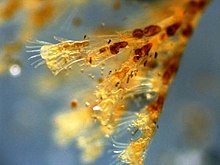Obelia
| Obelia bidentata | ||||||||||||
|---|---|---|---|---|---|---|---|---|---|---|---|---|
 | ||||||||||||
| Scientific classification | ||||||||||||
| ||||||||||||
| Species | ||||||||||||
|
Obelia dichotoma |
LIFE OF AN OBELIA
Hydroids (genus Obelia) are from the class Hydrozoa which consists of mainly marine and some freshwater species and have both the polyp and medusa stages in their life cycle. The phylum the Obelia belongs to is Cnidaria, which are all aquatic and mainly marine organisms that are relatively simple in structure.
HABITAT
Obelias are naturally found underwater in the ocean throughout the world. They are marine colonial hydrozoans that are found growing on algae and hard substrata in the subtidal. You can find them preferentially no deeper than 200 m from the water surface, growing in intertidal rockpools and at extreme low water of spring tides. These colonies also attach themselves to artificial substrata (pilings, harbour installations, buoys, bridge supports), bivalve cultures, and floating debris. Obelia is a cold water organism where water movement plays an important role to supply adequate food, gas exchange, remove waste products, prevent excessive siltation, and provide suitable substratum. Many hydroids are likely to be plentiful where water movement is sufficient but not too strong that it will cause damage. Hydroids tend to occur in low light conditions, possibly due reduced competition from algae and/or settlement preferences of their planulae larvae. .
LIFE CYCLE
The Obelia life cycle first starts out with the sessile, asexually producing polyp colony. During this stage of life, Obelia are suspended to substrate surfaces. On this mature colony there are individual hydranths called gastrozooids, which can be found expanded or contracted, to aid in the growth of this organism by feeding; and the reproductive polyp gonozooids that have medusa buds. Other hydranths are specialized for defense. The main stalky body of the colony is composed of a coenosarc, which is covered by a protective perisarc.
The next generation of the life cycle begins when the medusae are released from these gonozooids, producing free swimming male and female medusae velum with gonads, a mouth, and tentacles. The physical appearance of the male and female medusae velum, including their gonads, are indistinguishable, and the sex can only be determined by observing the inside of the gonads, which will either contain sperms or eggs. The medusae reproduce sexually, releasing sperm and eggs that fertilize to form a zygote, which later morphs into a blastula, then a ciliated swimming larva called a planula.
The planulae live in the free-swimming form for a while and eventually attach themselves to some solid surface, where they begin their asexually reproductive phase of life.
Once attached to a surface, a planula quickly develops into one feeding polyp. As the polyp grows, it begins developing branches of other feeding individuals, thus forming a new generation of polyps by asexual budding.
STRUCTURE
Obelia consist of two types of body plans of a polyp and medusa in their polymorphic life cycle. They are diploblastic with two true tissue layers - an epidermis, gastrodermis, and a jelly-like mesoglea filling the area between the two true tissue layers. They carry a nerve net with no brain or ganglia. A gastro vascular cavity is present where the digestion starts and later is intracellular. They have incomplete digestive tracts where the food enters, digests and expelled through the same opening. During the polyp stage, the mouth is situated at the top of the body, surrounded by tentacles, whereas during the medusa stage of life, the mouth is situated at the distal end of the main body structure. Four gonads lie in this main body structure, or manubrium. When food is taken in through the mouth, it enters the manubrium. The food is then distributed through a canal system, consisting of four radial canals and an outer ring. Defense and the capture of prey are helped by unique stinging cells called cnidocytes that contain nematocysts, which are triggered by the cnidocil.
REFERENCES
- B. Grzimek; Grzimek’s Animal Life Encyclopedia (Volume 1: Lower Animals); Van Nostrand Reinhold Company
- D. George; Marine Life: An Illustrated Encyclopedia of Invertebrates in the Sea'; Wiley-Interscience Publication
- E.P Solomon, L.R Berg, and D.W Martin (editor); Biology; Thomson Learning Inc; ISBN 0-534-39175-3 (6th edition, hardcover, 2002)
- J. Moore (editor); An Introduction to the Invertebrates; Cambridge University Press
- L. Gilbertson; Zoology Laboratory Manual; The McGraw-Hill Companies, Inc; ISBN 0-07-237716-X (4th edition, 1999)
- NCBI for some taxonomic information: http://www.ncbi.nlm.nih.gov/
EXTERNAL LINKS
- A Hydroid: Obelia Longissima: http://www.marlin.ac.uk/index2.htm?species/Obelon.htm
- The Double Life of Obelia: http://www.microscopy-uk.org.uk/mag/indexmag.html?http://www.microscopy-uk.org.uk/mag/artjul98/obelia.html
- General characteristics of phylum cnidaria
http://www.biosci.ohiostate.edu/~eeob/eeob405/labs/cnidariageneral.html.
